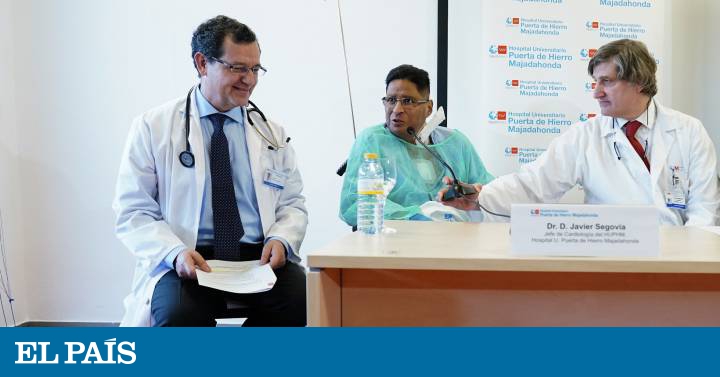Professionals of the Puerta de Hierro Majadahonda University Hospital (Madrid) have performed the first transplant in Spain of a heart from a patient killed by cardiorespiratory arrest. To date, all heart donations in Spain came from patients in brain death. This new technique, which was already used in four countries, can shorten the waiting list of hearts. "The technique has been used especially in Australia and the United Kingdom, Belgium has registered three cases and the United States began two months ago, almost simultaneously with Spain. We can say that we are at the forefront," says the Director General of the Organization National Transplant, Beatriz Domínguez-Gil.
Puerta de Hierro has held a press conference in which, in addition to Dominguez-Gil, the Madrid Health Councilor, Enrique Ruiz Escudero, and the transplanted patient, Jorge Washington, have participated. "He had a very limited life and this operation will improve his situation even if he has treatment for life," says the director general.
Organ donation of dead people after a cardiorespiratory arrest, or donation in controlled asystole, has been the main form of expansion of donation and transplant activity in recent years in Spain, to reach a third of the 749 total donations in 2019, according to data from the National Transplant Organization (ONT). However, until now, it was considered that the heart of a deceased person in these circumstances was not fit. "It is very sensitive to aging. Coronary arteries deteriorate a lot," Dominguez-Gil explains. Until now, the liver, kidneys and tissues were successfully transplanted to other patients.
MORE INFORMATION
The Spanish success in transplants, explained by those responsible
In recent years, more than 120 heart transplants after cardiorespiratory arrest have been performed in both Australia and Europe. In these cases, the organ, once removed, was recovered in an infusion machine before implantation. In Puerta de Hierro, the heart of the deceased patient was recovered before removal thanks to an extracorporeal circulation machine (ECMO), which keeps the organ oxygenated and functioning. Once the good function was confirmed, the heart was removed and implanted in the recipient. In donors of brain death, the heart continues to beat while in cardiorespiratory patients, and that did not generate much uncertainty about the state of the organ. The current machine validates that it is in good condition. Only hearts of young donors who had no cardiac pathologies are accepted.
Emotion in the #HUPH when Dr. Alberto Forteza, head of Cardiac Surgery at the center, shows the moment when the heart beats again and is ready to be transplanted pic.twitter.com/Z83we1JD8t
- ONT (@ONT_esp) February 17, 2020The use of ECMO for the recovery of the heart can result in cost savings with respect to the techniques used in other countries, in addition to allowing a more complete evaluation of the heart, according to the Community of Madrid. This procedure has been performed successfully previously only four times in the rest of the world.
Dominguez-Gil reports that the Bellvitge hospital in Barcelona has also succeeded in having the National Health System Transplant Commission validate its protocol for this operation. In a short period of time it is hoped that other Spanish hospitals that transplant hearts are added. "We believe that it could shorten the waiting list from 15 to 30 people a year. In 2019, 300 heart transplants were performed and 20 children and 149 adults await," says the director general.
Since the beginning of the heart transplant program at Puerta de Hierro in 1984, 945 heart transplants have been performed, positioning itself as the Spanish hospital with the most implants performed. This center was among the first in Spain to implement the controlled asystole donation program in 2012. Since then, 80 donors have registered with this procedure.

